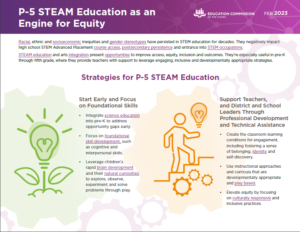For decades, racial, ethnic and socioeconomic inequities and gender stereotypes have prevented students from accessing science, technology, engineering and math (STEM) education. These barriers have negatively impacted high school STEM advanced placement course access, postsecondary persistence and entrance into STEM occupations. However, early STEAM education — which adds the “A” for arts — presents opportunities to improve access, equity, inclusion and outcomes.
This Policy Outline highlights strategies to provide STEAM education to students in pre-K through fifth grade and shares three innovative programs that are supporting equitable outcomes for young learners through STEAM education.
To learn more about STEAM education:
- Visit our Key Issue page on the topic.
- Read our Policy Brief that highlights the positive impacts of STEAM education for young learners and identifies trends in research.
- Read our Policy Outline that presents a high-level overview of the state-level actors who can play a central role in developing STEAM education.



